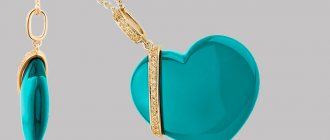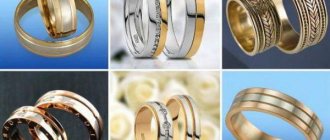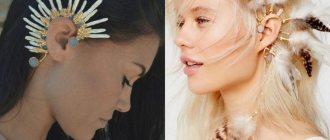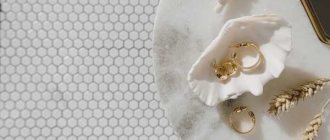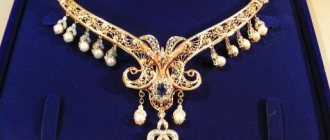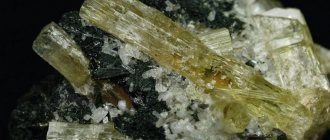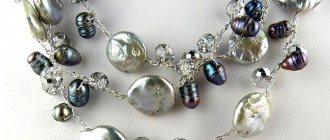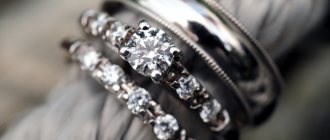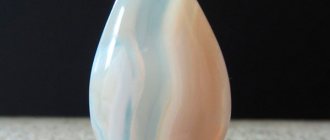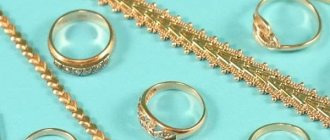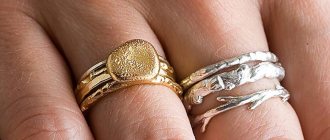HOW TO DISTINGUISH FROM A FAKE PEARL
First of all, you need to understand that there are natural and unnatural types of organic mineral. At the same time, cultivated specimens should not be indiscriminately classified as artificial: reserves of natural mother-of-pearl on Earth are depleted every year, and people sometimes help nature a little in its creation.
What types of pearls are there?
- Marine ones are the most expensive minerals; they are obtained from shells extremely rarely.
- Freshwater - such pearls are mined more often.
- Sea cultured - these stones are much more economical: they cost less.
- Refined is when cheap stones are slightly colored or x-rayed. X-rays change their shade.
- Fake - only beads made of glass, plastic or stone are considered fake.
Sea pearls
How to distinguish cultured pearls from artificial ones
The main rule: pearls that are grown by placing a bead in a shell are also essentially natural, so they are not considered artificial.
- “Mallorca”, or cultured pearls, differ from imitation pearls in the method of extraction. These are pearls whose cores are made of glass, but they are also covered with layers of mother-of-pearl, as the cores are placed in oysters.
- “Mallorca” was recognized as natural. At the same time, artificial pearls are created exclusively by people, without the participation of mollusks at all.
- The surface of “Mallorca” practically glows, shimmers with pinkish, creamy, blue highlights, and the fake mineral will shine brightly and evenly.
Majorca
How to distinguish natural pearls from artificial ones
The difference between natural and artificial pearls is also very noticeable in shape. We recommend: HOW PEARLS ARE FORMED
- Often genuine pearls are somewhat irregular in shape: elongated, elliptical, pear-shaped, egg-shaped.
- Shades are snow-white, pinkish, cream, greenish, blue, silver, purple, black.
- The brighter the shade of the beads, the higher the cost of the products.
- The most expensive natural pearls are black.
- A nuance: pearls can be as round as possible. These are cultured pearls and are also considered genuine.
- Natural specimens that grew in a mollusk in the form of a perfect sphere are rare: they are very expensive.
- Traders coat fake beads with special enamel so that their surface is also uneven.
Fake pearls
SECRET
You can take a closer look at the pearls if you put them in a glass of water.
If you scratch a fake bead with your fingernail, scratches from the nail will be visible or the paint will crumble.
Color, shine, beauty
Due to the fact that the current market is literally flooded with pearls, it is necessary to learn to distinguish a fake from a real high-quality product. The check is usually carried out according to several parameters:
- shine and color;
- mother of pearl quality;
- shape and size.
Natural pearls are easy to identify by their shine. A natural pearl shimmers and glows from within. If the pearl is of high quality, you will notice that there is a difference between the bright part and the shaded part. The result is a visual illusion of a ball inside the pearl.
Natural pearls have different colors; the palette includes about 120 shades. Among the expensive specimens there are pearls of black and white, bronze, green, silver, cream, gold, and purple shades. What color the pebble will acquire depends on the type of mollusk producer, the place of cultivation and the age of the pearl (degree of maturity). The rarest and most expensive stones are pink and blue.
More mother of pearl, larger size
The quality of pearls directly depends on the thickness of the nacre layer. This indicator has a significant impact on the price of the product. Another important factor in determining the quality of a pearl is the condition of the surface, how smooth it is and whether it is evenly colored. The presence of chips, dents, spots and other damage greatly reduces the value of pearls.
According to their shape, pearls can be:
- round (most often);
- spherical;
- in the form of drops;
- fantasy outlines (“baroque”);
- look like silhouettes of animals or various objects (they have a separate name - paragons). It is believed that such pebbles are endowed with special mystical properties and are natural talismans. Most often, the frame for paragons is gold.
The shape of pearls is best viewed against a black background, then any defects will become more noticeable. In a high quality finished product, all pearls should be the same size and lie flat. The holes should be in the center.
With sizes, everything is simple - the larger the pearl, the higher the price. The size is determined by the diameter, counted in millimeters. River pearls, being smaller ones, usually range from 3-11 mm, while sea pearls can reach 22 mm.
For jewelry, the weight of large pearls is usually determined in grains or carats. Small pearls are called grain pearls and are sold by weight. Large pearls are very rare. The largest pearl was discovered in 1934 near the Philippines. This miracle of nature weighs 6.35 kg, looks like a head in a turban, and therefore has the name “Pearl of Allah”. Large elite pearls are usually included in the register of the state's foreign exchange reserves along with other precious stones.
Affordable luxury
The cost of pearl jewelry ultimately depends on many factors - from origin and size to shape and surface quality. Therefore, you can choose a product that is completely suitable both in price and in appearance and quality. Buy and wear with pleasure, because they say that a stone is alive and can get bored and die in a box. Try to prevent this, let pearls regularly show themselves and decorate your cute image.
In the following articles, our experts tell you how to choose the right umbrella and the secrets of choosing an engagement ring.
Pearl beads of different lengths
The so-called “collar” (collar) has a length of about 30-32 cm. Usually this is an ornament consisting of 2-3 threads. They fit snugly to the neck, without sagging and somewhat shortening it visually. Therefore, it is more suitable for owners of a long slender neck. Look great with a deep neckline.
Cowl beads do not exceed 35-40 cm. Classic, single-strand pearl beads wrap around the base of the neck. They can also consist of 2-3 threads. The modesty and elegance of the jewelry allows it to be worn with both luxurious outfits and office suits. A choker necklace is incompatible with high collars that hide the beauty of the beads.
Pearl beads 42-48 cm long, called
“princess” , freely descend to the chest.
Visually, this lengthens the neck, so it can be worn by ladies with both full and short necks. If the pearls are small, they can be supplemented with a pendant. Beads with large pearls are an independent decoration. Long beads up to 60 cm – matine (morning). They are worn with cocktail dresses, evening dresses, and office suits. It is not advisable to combine with clothes with buttons, which distract from the beauty of pearl beads.
A decoration 80-90 cm long is called “opera” . In the evening version it is worn in one thread; during the day it can be wrapped around the neck twice. In combination with contrasting clothing, such beads visually make you look slimmer.
The longest pearl jewelry – about 115 cm – is a rope (rope). It is worn in 1-2-3 rows. The beads can be tied in a knot or wrapped around your hand, turning them into a bracelet. There is a type of bead of the same length called “lariat” (lasso). Their difference is that the beads are not connected, i.e. have free ends. They are worn in a variety of ways - tying them, wrapping them around the neck like a scarf, using them as a belt, hoop or bracelet.
Caring for pearl beads: basic rules
Since pearls have a limited lifespan, beads require some care. The most important thing is that they need to be worn more often, since pearl beads need moisture so that they do not lose their shine and do not dry out longer. They are negatively affected by high temperature, hypothermia, perfumes, creams, and chemical exposure. For cleaning, rinse in clean water and wipe with a damp cloth. Beads should be stored separately from other jewelry, wrapped in natural fabric. Ideally, every 5-6 years it is advisable to re-string them on a new thread.
JEWELRY - BEADS | NATURAL PEARL AND ITS TYPES
History of beads | Main types of beads | Beads under the neckline of the dress. How to choose beads? | Beads on a chain and other basics. How to collect beads correctly? | Chanel beads | Felted wool - beads. How to make felt beads? | Sling beads for mothers. Beads for children from 3-4 years old | What beads are in fashion? | The most luxurious necklaces | Beads for men | Beads made of glass - Czech and Murano
Share this article with your friends
Works by designers from the JEWELIRUM catalog
- Co.Cos Jewelry
- Co.Cos Jewelry
- Taiga Jewelry, Tomsk
- Taiga Jewelry, Tomsk
- Ilya Maksimov, Crimea
- Ilya Maksimov, Crimea
- UBIRING
- UBIRING
- Diamonds are Forever
- Diamonds are Forever
- Rings in natural style, Sergacheva Jewelery
- Earrings with pearls, Sergacheva Jewelery
- Cabochon ring, Minty Sky
- Fly earrings, Minty Sky
- Ring, Precious Park
- Ring, Precious Park
- Snake skin ring, Stoyanova Jewelery
- Chain earrings, Stoyanova Jewelery
- Children's pendant - stick, Matthew&Daniel
- Pendant for a child, Matthew&Daniel
- Bracelet, Svetlana Subbotina
- Ring with Slavic symbols, Svetlana Subbotina
- Indian style ring, Anna Goffman
- Indian style ring, Anna Goffman
- Earrings, ISTA
- Geometric ring, ISTA
- Earrings with enamel, PNJewelry
- Ring with enamel, PNJewelry
- Ring, Khramtsova Jewelry
- Ring, Khramtsova Jewelry
- Wedding rings to order, obruchalki.com
- Wedding rings to order, obruchalki.com
- Earrings, Yuri Bylkov
- Earrings, Yuri Bylkov
- Titanium bracelets, LanaMuransky
- Titanium pendant, LanaMuransky
- Brooch Elephant (after Salvador Dali), THING
- Ring Veil, THING
- Mace earrings, VLADIMIR MARKIN
- Cufflinks, jewelry mechanics, VLADIMIR MARKIN
- Drop-shaped ring, EKATERINA TOLSTAYA
- Drop-shaped earrings, EKATERINA TOLSTAYA
- Necklace with amber, LETA
- Earrings with amber, LETA
- Children's earrings, combinable, FASHBY
- Children's earrings, combinable, FASHBY
- Ring of architectural form, Elizaveta Malafeevskaya MANU_L
- Architectural bracelet, Elizaveta Malafeevskaya MANU_L
- Set Ginkgo Leaf, SHABUT JEWELLERY
- Brooch Wearable porcelain, SHABUT JEWELLERY
- Architectural ring, GEOMETRY
- Brooch, porcelain, GEOMETRY
- Necklace made of polymer clay, LICORNE ART
- Brooch made of polymer clay, LICORNE ART
- Ring, avant-garde, VALERY SEREDIN
- Bracelet, avant-garde. VALERY SEREDIN
- Wooden set, Scandinavian/Japanese minimalism, VLADIMIR SHESTAKOV
- Ring, Scandinavian/Japanese minimalism, VLADIMIR SHESTAKOV
- Earrings, TON ANT
- Ring, TON ANT
- Architectural ring, ANCHOR
- Architectural necklace, ANCHOR
- Earrings, GOHFELD JEWELLERY
- Necklace, GOHFELD JEWELLERY
- Massive ring, YAKISCHIK
- Designer jewelry, YAKISCHIK
- Architectural ring, ONE DAY ART
- Architectural ring, ONE DAY ART
- Brooch, bionics, VALERIYA MARKOVA (TESSA)
- Unclosed ring, bionics, VALERIYA MARKOVA (TESSA)
- Ring, bionics, BEAVERS
- Earrings, bionics, BEAVERS
- Earrings, asymmetry, VAGANOVA JEWELRY
- Airplane ring, VAGANOVA JEWELRY
- Flower ring, ALCHEMIA JEWELLERY
- Set, ALCHEMIA JEWELLERY
- Pendant-cat, ethnic, STUDIO OF ILYA AND VERA PALKIN
- Earrings, STUDIO OF ILYA AND VERA PALKIN
